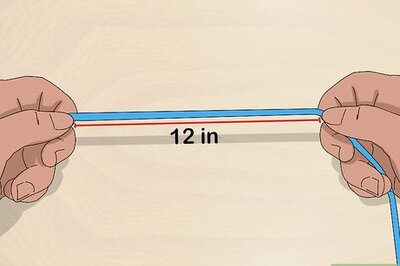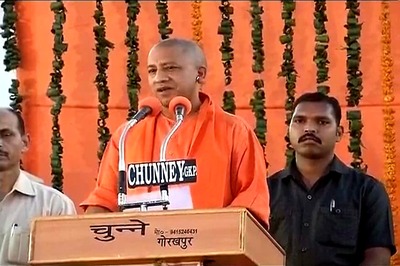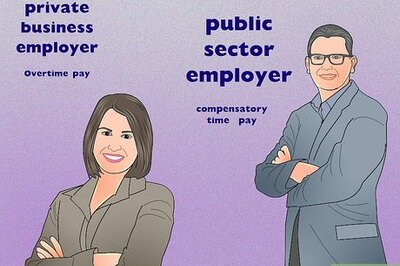
views
Kavassery (Kerala): Frenzied mass participation characterises annual temple festivals in Kerala that invariably include colourful processions of richly caparisoned elephants and panchavadyam (orchestra) by a combination of percussion instruments. Other highlights of the February-May festivals - known as pooram, arattu, vela or kummatti in different places - are spectacular fireworks displays at night and puja and age-old rituals in the temples that seek to provide spiritual nourishment.
Large groups of men, women and children from villages and towns trek to the venues honouring Hindu gods and goddesses, comparable to the Durga Puja in Bengal and Diwali and Dussehra in the north. The festivals have been held in hundreds of temples across Kerala for decades and create a passion among the organisers and supporters who compete among themselves to put up a great show in terms of content. The number of elephants in the processions varies from five to 50 although there used to be more than 100 of them in the pooram at Arattupuzha, near Thrissur in central Kerala, in earlier years.
The grandest festival takes place in Thrissur town. Said to have been inaugurated in 1798 by the local Raja to end infighting between two major Hindu temples, the Thrissur pooram is the main event in Kerala's cultural calendar, drawing tens of thousands of Indians and foreign tourists. The 36-hour "mother of all poorams" is a riot of rhythm, elephant processions and fireworks.
The Paramekkavu Bhagavathi temple and the Thiruvambadi Sreekrishna temple hold the festival in a spirit of friendly competition. The pooram is held in the premises of the Vadakkumnathan temple, dedicated to Lord Shiva. The festival is assumed to be about two centuries old. Due to its grandeur, it is known as the Pooram of Poorams (literally festival of all festivals).
The elephants, adorned with golden armour, stand in formation and three men mount atop each of them. One man carries fans made of peacock feathers (aalavattom), another swings batons with plumes of white fur (venchamaram) and the third holds a brightly coloured umbrella (kuda) high above the elephant's back.
In sync with the drum beats, the riders wave the parasols and fans, adding to the visual splendour. One of the elephants carries the head priest holding the image of the deity that is honoured in the celebrations.
Of the five instruments in panchavadyam, four belong to the percussion category -- timila, maddalam, ilathalam and idakka -- while the fifth one, kombu, is a wind instrument. The traditional orchestras are called Panchavadyam, Thayambaka, Pandi Melam and Panchari Melam.
The orchestra begins at a slow pace and then scales on to a medium tempo, eventually culminating in high, frenzied speed. The old and young onlookers wave their arms above the head to indicate their appreciation of the beats kept up by the drummers. The exercise is repeated every year, but there is no question of monotony as the lead drummer is an expert capable of introducing new rhythms as often as needed to bring about a change in the audience's mood.
In another exercise to enthuse visitors, colourful umbrellas are whipped and unfurled atop the elephants in quick succession. The scene of colour and beauty and sound, enthusiastically applauded, is difficult to erase from one's memory. The Pooram festival comes to an exciting close after a wide variety of fireworks explode at night.
Among the other prominent festivals in Kerala are the Nemmara Vallangi Vela, Kavassery Pooram, Chinakkathur Pooram of Palappuram and Vayilliamkunnu Pooram of Kadampazhipuram, Akathethara Thekkethara karthika vela. Vishnu Vela of Thumbalamkad is one of the most entertaining festivals.
Here is an account of some of the other festivals:
In Kavassery, the competition is among three desams (localities) - Kazhani, Vavulliapuram and Kavassery - that jointly hold the pooram, especially in fireworks as well as elephant processions. One specialty in the region is the competition among them in preparing decorated wooden horses, each of which is carried by scores of men to the temple of Parakkattu Sree Bhagavathi, in whose honour the week-long pooram festival is held. Pooram this time was preceded by four cultural evenings when well-known singers and dancers gave their performances.
Aarattupuzha Pooram, with the largest elephant stage entry, celebrates its annual pooram festival in March. The Ayyappa temple at Aarattupuzha is just 14 km from Thrissur and the pooram is conducted with 61 caparisoned elephants bearing bright-coloured umbrellas and parasols, presenting an unparalleled spectacle. Legend has it that the patron deities of the neighbouring villages ride majestically caparisoned tuskers to arrive in a procession at the Arattupuzha village on the festival day. the festivals here are not merely religion-oriented. They reflect in them the social and cultural ambience of the state.
In Palakkad district, the festivals begin in February with the vela in Padur, five kilometres from Kavassery. The excitement of vela starts one month with people cleaning and painting their houses. People from Padur village who stay in other places also come to attend this festival.
This festival features lot of fireworks, elephant processions, and other cultural events. The festival is celebrated as birthday of Lord Sree Panickanar, an incarnation of Lord Ayyappa. This temple is one of the rarest of its kind as the idol is formed on its own (swayambhu). The Vela season comes to an end with Mudappallur, Kannambra and Mangalam Vela, which happen in May.
The Bharani festival in the Kodungalloor Bhagavathi Temple commemorates the victory of the goddess over the demon Darika. A large congregation of Velichappadus or oracles arrives in the temple as part of the festival, known for its bawdy songs. The huge idol of Bhadrakaali, with eight hands, each holding weapons like swords and wheels, evokes reverential fear in the minds of the devotees. The oracles dressed in red costume and with streaming hair, smear their body with turmeric powder, wear huge waist belts studded with bells and hold aloft sacred swords of different sizes and shapes.
Once in a trance, these oracles perform a frenzied dance, repeatedly slashing their foreheads with curved swords. As a supreme symbol of devotion they make a sacrificial offering of their own blood to the deity. A grand procession with nine majestic tuskers is held in the evenings followed by a series of cultural programmes staged in the temple premises.




















Comments
0 comment